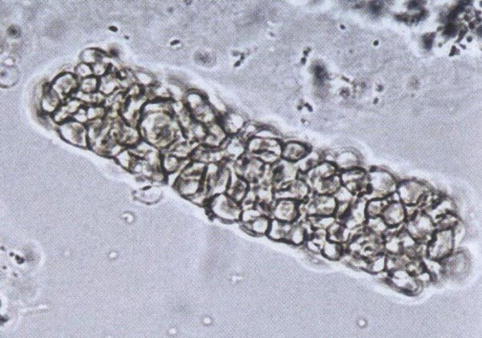and Christopher Isles2
(1)
Institute of Cardiovascular and Medical Sciences, University of Glasgow, Glasgow, UK
(2)
Dumfries and Galloway Royal Infirmary, Dumfries, UK
Q1 What is haematuria and how is it classified?
Haematuria simply means the presence of red blood cells in the urine. The Renal Association and the British Association of Urological Surgeons have recently recommended that haematuria is classified as visible (previously macroscopic) or non visible (previously microscopic). Non visible haematuria may be spurious, transient or persistent and also symptomatic (urgency, frequency, dysuria) or asymptomatic. Causes are usually urological but may also be renal – the figure shows a red cell cast in a patient with glomerular (renal) haematuria (Fig. 4.1).


Fig. 4.1
Red cell cast. Urinary casts are cylindrical structures formed in the distal convoluted tubule & collecting ducts. Red cell casts are always pathological, and in cases of non-visible haematuria indicates glomerular damage
Q2 What is meant by the term spurious haematuria?
The commonest cause of spurious haematuria is contamination of the urine specimen by menstrual blood loss. The term is also used to describe false positive dipstick tests which occur in rhabdomyolysis and haemoglobinuria because myoglobin and haemoglobin cross react with the chemical reagent on the test strip; and the red or pink urine that is sometimes seen with foods such as beetroot or drugs such as rifampicin.
Q3 What are the causes of transient haematuria?
The two most important ones are urinary tract infection and vigorous exercise. Patients with suspected uncomplicated urinary infection should receive an appropriate empirical course of antibiotic e.g. trimethroprim followed by repeat urine dipstick 2 weeks later. If the follow up dipstick is negative no further tests are required. See below for what to do if the dipstick is positive
Q4 What is the risk of urological malignancy?
The likelihood of finding a urological malignancy in a patient with haematuria depends on age, gender and whether the haematuria is visible or non visible, as shown in the box below.
Box 4.1 Likelihood of Finding Malignancy Following a Presentation with Haematuria
Non-visible (%) | Visible (%) | |
|---|---|---|
Male >40 year | 8 | 24 |
Male <40 year | 1 | 7 |
Female >40 year | 4 | 19 |
Female <40 year | 0 | 0 |
Khadra, et al. Analysis of 1930 patients with haematuria. J Urol. 2000;163:524–27; with permission from Elsevier
< div class='tao-gold-member'>
Only gold members can continue reading. Log In or Register to continue
Stay updated, free articles. Join our Telegram channel

Full access? Get Clinical Tree







